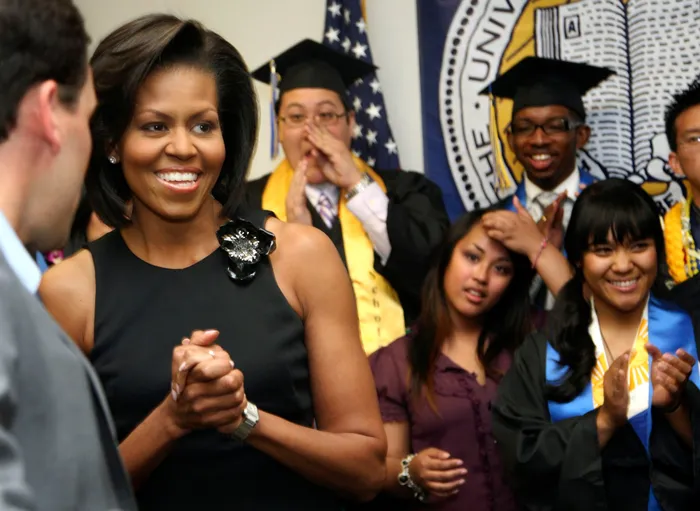As affirmative action dies, how can fairness thrive?

Picture: Robert Galbraith/REUTERS/Taken on May 16, 2009 – US First Lady Michelle Obama talks with graduating students prior to during her address to the first four-year graduating class at the University of California Merced in Merced, California. Students suffering the most are not those who would’ve, could’ve, should’ve gone to Harvard, but because affirmative action died, will have to “settle” for Boston University. Those suffering the most are those denied the chance to go to college at all, the writers say.
By Frances Moore Lappé and Graham Backman
To right the wrongs of the Supreme Court decision, let us rethink access to higher-ed from the bottom up.
Could the death of affirmative action stir us to face the many barriers to educational equity hiding in plain sight?
Among Organisation for Economic Co-operation and Development countries we rank sixth, just behind the UK, in “most educated population”. Not bad, but we can do better. Standing in our way is the daunting cost of higher education combined with income inequality more extreme than in 110 nations. Such inequality most harms Americans of colour: a group whose poverty rate in 2019 was more than double that of non-Hispanic white Americans.
Even our public universities require a family to come up with over $100,000 for a child’s four-year education. From 2010 to 2020 the yearly average tuition and fees at public universities grew from $7,132 to $9,349 and at private universities from $22,677 to $32,769. Of course, families must cover housing and living expenses as well.
We need to ensure more Americans can access the socio-economic springboard that is higher-level education. We can do this by building more public universities; but without the exclusivity found today at many top-class public institutions.
One reason the cost is so high is that for years our colleges and universities have not kept up with growing demand. Over a decade, 2010 to 2020, our population grew by 23 million while the number of degree-granting institutions fell almost 15 percent, from 4,599 to 3,931. The number of undergraduates dropped by about 3 million.
Yet, earning an undergraduate degree, compared to only a high school diploma, has huge, life-long impacts: Without that degree you are twice as likely to be unemployed. Plus, lifelong earnings are 75 percent lower without a bachelor’s degree. Overall, despite the burden of college debt, the return on investment associated with getting a degree is 14 percent — double that of investing in stocks.
These forces have created a squeeze on upper-level education, as more potential students face fewer and fewer opportunities at universities.
As competition tightens it should be no surprise that in 2017, 38 top US institutions of higher education had more students from the top 1 percent of earners than from the entire bottom 60 percent of earners.
Children with stronger financial footing no doubt feel more parental pressure to go to college and are more likely to have impressive applications. Colleges are 1.5 times more likely to give wealthier students higher scores for extracurriculars than their lower-class peers. Of course, many differences give them an edge: Better-funded schools — due to their towns’ higher property values — no doubt offer superior learning opportunities. Additionally, instead of having to rush to an after-school job, children in wealthier families can pursue their hobbies and academic interests.
More than half of students with 1500+ SAT scores have parents in the top 25 percent of earners, and one-fifth of top SAT scorers come from the top 1 percent. True, 80 percent of schools don’t require these standardised tests. Nonetheless, a good score still gives one an advantage.
Finally, from a purely fiscal perspective, a university would rather admit a kid paying full tuition than one admitted with reduced tuition and loans.
With the number of total undergraduates falling and the share of better-prepared wealthy applicants growing, potentially outstanding students are left behind as opportunities disappear. They are disproportionately Hispanic and African American.
Driving this injustice in college admissions is the overall shortage of opportunities in higher-ed. Students suffering the most are not those who would’ve, could’ve, should’ve gone to Harvard, but because affirmative action died, will have to “settle” for Boston University. Those suffering the most are those denied the chance to go to college at all.
We need to ensure more Americans can access the socio-economic springboard that is higher-level education. We can do this by building more public universities; but without the exclusivity found today at many top-class public institutions.
Those applying to the upper echelon of schools don’t need more options. Instead, our goal must be making higher-level education available to those now choosing the workforce when, in their hearts, they want education. We need more UMass Bostons (accepting 79 percent of applicants) and UC Merceds (accepting 87 percent) — schools that create the diversity in universities that was long the goal of affirmative action.
To achieve racial and economic justice, let us seize the sad death of affirmative action to motivate enlarging educational opportunities for all. We will then no longer fail the poorest Americans of all races.
Frances Moore Lappé is the author of 20 books, beginning with the acclaimed ‘Diet for a Small Planet’. Most recently she is the co-author, with Adam Eichen, of the new book, ‘Daring Democracy: Igniting Power, Meaning, and Connection for the America We Want’. She is co-founder of the Cambridge, Mass.-based Small Planet Institute. Graham Backman is studying political science at the University of Massachusetts, Amherst, and is a democracy intern at the Small Planet Institute.
This article was published on Common Dreams
Related Topics: